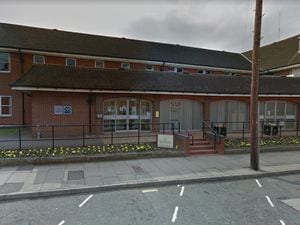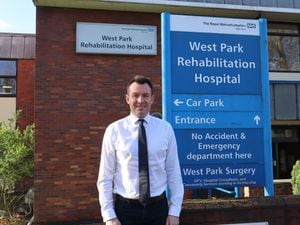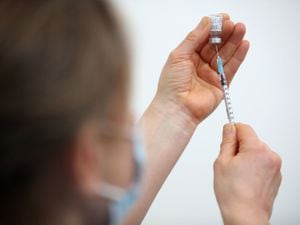Revealed: The long A&E waits at your hospital amid NHS emergency care crisis
Thousands of patients at hospitals across the Black Country and Staffordshire have been forced to wait for four hours or more in A&E over the last year, new figures show.
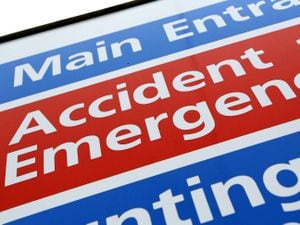
People have been urged not to attend hospital A&E departments unless they absolutely have to as the true extent of the region’s crisis in emergency care was revealed.
In hospital A&E units across the Black Country and Staffordshire over the last year, 156,967 patients waited for four hours or more to be dealt with, according to new figures from NHS England.
It means that almost a quarter of all patients seeking emergency care waited for four hours or more – missing the official NHS target. The figures come ahead of the winter rush, which sees A&E departments put under increased strain.
Not a single emergency department in the region got within 10 per cent of hitting the benchmark of 95 per cent of patients to be discharged, transferred or admitted to a ward within the four-hour period.
Dr Chris Moulton, vice president of the Royal College of Emergency Medicine, said the figures showed the pressure on A&E departments had ‘spiralled out of control’.
“If you keep stretching an elastic band, eventually it will snap,” he said. “You don’t ask ‘why did the elastic band snap’ – it snapped because you stretched it.”
The picture where you live
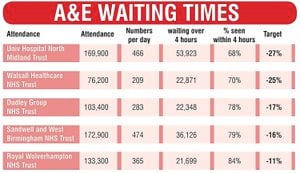
Wolverhampton
More than one in six people waited four hours or more to be seen at New Cross Hospital’s A&E department over the past year.
The managing trust, The Royal Wolverhampton NHS Trust, is not meeting Government waiting times targets.
The figures from the NHS England showed that out of 133,328 patients seen at hospital over 2017/18, 21,699 waited more than four hours.
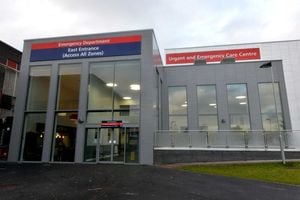
The proportion of people seen within four hours was 84 per cent.
It falls short of the 95 per cent target, introduced in 2010.
A spokesman for Royal Wolverhampton NHS Trust said waiting times performance had ‘steadily increased’ over the past five months.
He said in August, 93 per cent of patients were seen within four hours at A&E.
He added: “Some people may have a longer wait than others as we always prioritise our sickest patients.
“We are doing all that we can to ensure patients are not waiting longer than necessary.
"To ease the pressure I advise patients to make the local pharmacy their first stop for help with minor illnesses this winter.”
Staffordshire
Almost one in three patients waited four hours or more to be seen at Staffordshire’s two A&E departments over the past year.
The University Hospitals of North Midlands NHS Trust is not even close to meeting Government-set targets.
The trust is the eighth-worst trust for A&E waiting times out of 139 in the country, according to the 2017/18 figures from NHS England.
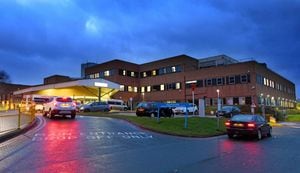
They show that out of 169,922 patients who entered the A&E departments at County Hospital in Stafford and Royal Stoke University Hospital, 53,923 had to wait more than four hours.
The proportion of people seen within four hours is 68.3 per cent – well short of the 95 per cent target, introduced by the NHS in 2010. Other NHS trusts, partly affected by the closure of Stafford’s A&E department at night, also performed badly.
University Hospitals of North Midlands NHS Trust chief executive Paula Clark said: “We are already working towards winter 2018/2019 by increasing the number of hospital beds, including the £8.8m construction of two new wards.
“I would like to reiterate our thanks to patients and their relatives for their understanding and support, and our staff for their efforts to make patients as comfortable as possible when we were at our busiest.”
The two wards will provide 64 more beds at the Royal Stoke University Hospital. The trust currently has 1,450 beds.
She added: “Nationally A&E attendances are increasing and this has meant the NHS hasn’t achieved the target for the past four years.
“UHNM is no different to other NHS providers in this respect, however, since March 2018 A&E performance has continuously improved, with over 90 per cent of our patients being seen within four hours in August 2018.
Dudley
More than 20,000 people waited four hours or more at Russells Hall Hospital’s A&E last year.
Just 78 per cent of patients were seen within the NHS benchmark waiting time of four hours at the Dudley Group NHS Trust – missing the 95 per cent target by a huge 17 per cent.
Figures from NHS England show that 22,348 patients waited for more than four hours at the emergency department in 2017-18, before being discharged, transferred or admitted to a ward.
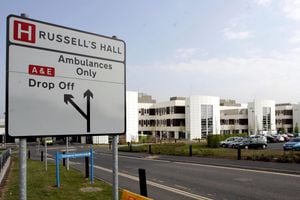
Bosses put the failings down to an increase in patient numbers, with the hospital dealing with around 700 more patients last year than in 2016-17.
It comes as A&E services at the hospital remain under investigation over dozens of deaths, and follows a Care Quality Commission report which gave emergency care the lowest possible rating of ‘inadequate’.
According to NHS England an average of 283 people a day were seen by the trust’s A&E department in 2017-18.
Diane Wake, chief executive of the Dudley Group Trust, said: “We continue to work closely with our partners and are doing all we can to achieve the target of 95 per cent.”
Russells Hall Hospital last achieved the target in a single month in March 2017.
Sandwell
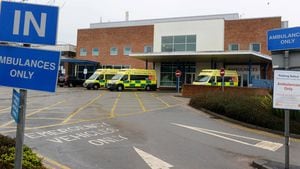
One in five people waited four hours or more to be seen at Sandwell and West Birmingham NHS Trust’s two hospital A&E departments.
It means the trust, which runs both Sandwell General Hospital and City Hospital in Birmingham, is not meeting Government targets.
Chief executive Toby Lewis accepted ‘on many days’ the trust was not meeting standards set by the NHS for A&E waiting times.
Changes are to be made at the hospitals this month, he said.
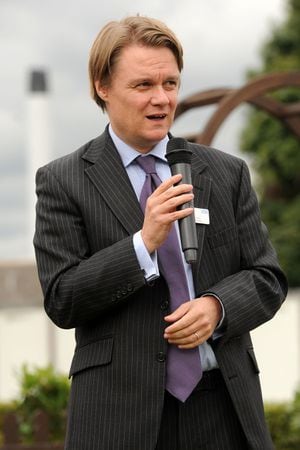
Figures from NHS England show that out of 172,920 patients seen at the hospitals’ A&E departments in 2017/18, 36,126 waited more than four hours.
The proportion of people seen within four hours is 79.1 per cent.
Mr Lewis said: “Our staff and GP partners continue to work hard to provide good care. On many days we are meeting the standards set in the NHS Constitution, but not every day and not most nights.”
He said a series of changes would be brought in over this month ‘designed to improve pace’.
Walsall
More than 20,000 people waited four hours or more at Walsall Manor Hospital’s over-crowded A&E department last year.
Just 70 per cent of patients were seen within the NHS benchmark waiting time of four hours at the Walsall Healthcare NHS Trust – missing the 95 per cent target by a huge 25 per cent.
Figures from NHS England show that 22,871 patients waited for more than four hours at the Manor’s emergency department in 2017-18, before being discharged, transferred or admitted to a ward.

It comes as health bosses in the borough wait to find out if a bid for £36.2 million in Government funding to expand A&E services has been successful.
Bosses put the failure to hit the target down to an increase in patient numbers – the Manor seeing 2,400 more people than in 2016-17.
Walsall Healthcare NHS Trust’s chief operating officer, Philip Thomas-Hands, said the trust continued to work with partners to improve its overall hospital four hour performance and patient experience within urgent care.
He said: “We have further developed our Frail Elderly Service to help frail residents avoid being unnecessarily admitted to hospital.
“We co-ordinate with health and social care to ensure that patients who have long-term conditions are supported at home so that we avoid admission to hospital wherever possible.
“And finally we would reiterate our message people to avoid ED unless they have life-threatening or serious conditions so that our teams can prioritise those most in need as quickly as possible.
“People should get expert health advice by telephoning NHS 111 speaking to their local pharmacist, or contacting their own GP practice.”
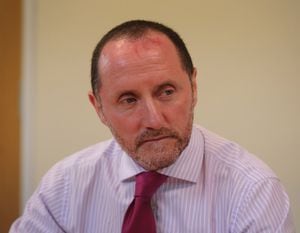
Eddie Hughes, the Conservative MP for Walsall North, said people needed to seriously consider whether they needed to attend emergency departments.
“Clearly the performance needs to improve, but one of the main problems is that too many people are attending A&E with problems that could be dealt with elsewhere,” he told the Express & Star.
“In Walsall and in other areas GP appointments have been extended to evenings and weekends to encourage people to use this service rather than head straight for the emergency department. There needs to be a more appropriate use of resources.
“The message to patients is: Do not use A&E departments unless you have to. If more people go to the pharmacy instead of their GP, then their GP instead of A&E, we would eventually see a drastic improvement in waiting times.”
Mr Hughes added that when it came to people with serious health issues, he believed that the vast majority of emergency departments fast-tracked such patients and did not put lives at risk.



